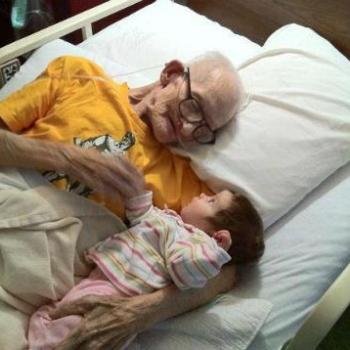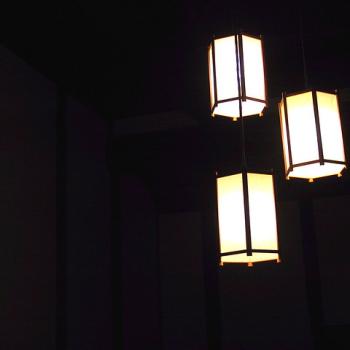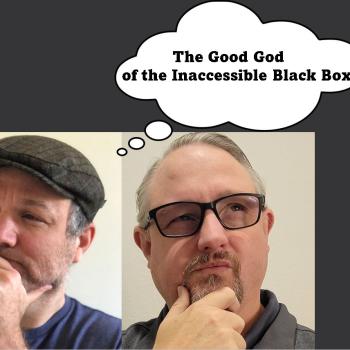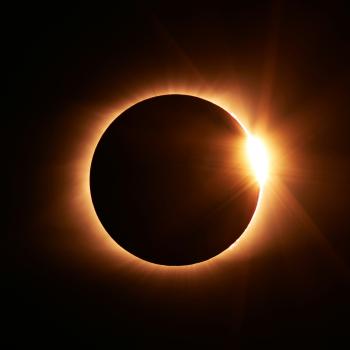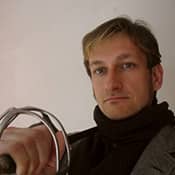There are little signs of respect. Habits that everyone knows. When you cross a river, you make this gesture for the spirit of the place. You look both upstream and downstream and make this gesture and then you cross the river.
Some people don't do it. Maybe they acknowledge it in silence. Maybe they don't believe in river gods. Whatever. They recognize the gesture anyway, as Jews recognize the sign of the cross and civilians know the military salute.
These gestures are used elsewhere. When entering or leaving a forest; when taking in a mountain view; at sunset or sunrise; when you first see the moon. On entering a city, or a sanctuary. Anywhere you cross from one place to the next you may see people show a little sign of respect. Like asking permission before they barge in.
You hear personal pronouns. Less "it," more "he" and "she." The rivers are usually she, the mountains and sky usually he. Sometimes it's foggy: the sun is female or male depending on the speaker.
Offerings are normal. Every street has a shrine. The shrines are small, some little more than ledges for candles and offerings. No two look exactly the same. A lot of the time they're built by homeowners, right on the edge of their yard where it meets the sidewalk. The city could never build a religious shrine but private citizens can. They're available to any passerby.
These shrines represent a tangled garden of traditions and viewpoints. Some are carefully appointed, routinely cleaned and whitewashed. Others accumulate stains and graffiti from years of use. Some have an overhanging roof to shelter from the rain, others stand open to the elements. Occasionally you see one with very specific traditions and a stack of informational brochures. Most are use-as-use-will. There is nothing orthodox about them.
Sometimes these shrines are vandalized. Soon they end up back in service.
Non-Pagans stop at the shrines. They take their picture there or chat in the shade. Some put down offerings even though they don't believe. At times they leave strange things: half a fast-food cheeseburger, a post-coital mousetrap. The line between votive and vulgar is hard to define, and most don't bother. In this community-policed effort, if it doesn't knock down the shrine it's probably all right.
The use of the shrines is hard to explain to foreigners. Why do so many people make offerings if most aren't believers? Oh, well, I don't know—ask twenty people, get eighteen answers. Are the shrines religious, or aren't they? I don't know. It's just how things are. Live here awhile.
A city of glittering votives is too tantalizing. It calls to you. Then it becomes part of life.
There are temples, too. Most are small. They belong to organized groups with their various traditions, but they all do triple service as community centers and rent-a-shrines. Most groups lease a few hours a week for their ceremonies and celebrations. It's all very ad-hoc and it works out in that block party kind of way.
This world seems like a fantasy to so many Pagans. We have seen groups rise and fall, temples open and close. The history of the Pagan movement is more often told by its obstacles than by its successes.
But the world I describe is a very real place. It is not different than the way Hinduism pervades India, or Vodou in New Orleans, or Catholicism in Mexico. These are all places where a religious tradition, not practiced by everyone, has gained a cultural dimension and feeds into community life.
There's something truly touching about the votive candles under the tree outside the church in Valladolid, Mexico. I'd sooner undergo crucifixion myself than actually practice Christianity, but I dropped a coin in the box and lit a candle before going on my way. Too tantalizing, even for me.
It's not a numbers game. Sure, the Church is dominant in Mexico. And Hinduism has had a few thousand turns of the wheel to get itself rooted. But New Orleans is a perfect example: only a tiny, tiny handful of people there practice Vodou. Until recently Vodou was almost universally scorned and misunderstood. But there is a sort of citywide pride about Vodou in NOLA, a total buy-in that this is an exciting part of who we are. It goes beyond the veve tattoos and the lwa t-shirts; it does better work than the commodified pop-voodoo of tourists. You will find their candles burning, their beads worn, their priests and priestesses consulted, their rhythms hummed and drummed and woven into the everyday.
